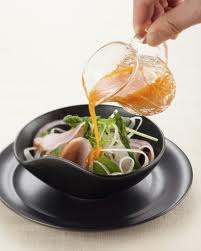
Making Plant Food Sing
Transforming healthy vegetables and fruits into delicious dishes is easy with the simple addition of a flavorful dressing. Make your own and enjoy preservative free, inexpensive and always fresh dressings.
The culinary world names five flavors that speak to your palate and subsequently your brain translates the message as delicious or icky or somewhere in between.
Our perception of the taste of food is determined by the interaction of tastes, aromas and “mouth feel” produced by the ingredients. A food tastes good to you when it is balanced with the five flavors or when one of those flavors is emphasized to achieve a specific taste. And we all perceive differently.1
The Five Flavors
Salty, Sweet, Sour, Bitter and Savory. The Japanese have named savory as umami. Umami comes from the Japanese word umai, meaning delicious, and can be described as savory. It can be accomplished by adding a little butter or a sprinkle of parmesan cheese. Umami is imparted by amino acids called glutamates, found in meat, fish, dairy, vegetables and fruits, such as olive oil. Taste buds, clusters of sensitive cells are distributed across the entire surface of the tongue. These clusters of cells have different degrees of sensitivity to the basic tastes.2
Making your own dressing is easy and fun
Making a salad dressing or dip involves using ingredients that contain the five flavors blended to complement each other and the dominant flavor of the food they will dress. Dressings generally include fat, acid, salt, sweetness and seasoning.
Fats, like olive oil, nut and seed oils provide the “ride” for vinegars and lemon juice as the acids. Yogurt, sour cream and buttermilk are useful acids that add richness and smoothness. The fat to acid ratio can be 4:1, 3:1 or 2:1, depending upon the intensity of the flavors in the oil and the acid. Dressings can be made simply in a jar with a lid or in a blender. Let them rest for a while at room temperature so the flavors blend.
Beyond salt, the seasoning can come from many sources. Choose complementary accents based on the flavors in the food you are dressing. To test your blend, dip a piece of lettuce into the mixture as opposed to tasting from a spoon.
Deborah Madison outlines these additions in her wonderful book Vegetarian Cooking for Everyone.
For sharpness – capers, olives, green peppercorns, salty cheeses
For liveliness – diced shallots, scallions, chives, pickles, citrus rind
For pungency – fresh garlic, fresh black pepper, mustard and horseradish
For mystery – citrus juices
For spice – ginger, cumin, paprika, fresh herbs
For sweetness – roasted red peppers, honey, maple syrup
Have fun blending your favorite tastes, oils and vinegars until you create your own signature dressing.
1 http://www.aromadictionary.com/articles/tonguemap_article.html
2 http://www.nytimes.com/2012/03/20/science/no-clear-cut-taste-map-of-the-tongue.html?_r=0
Leave a Reply